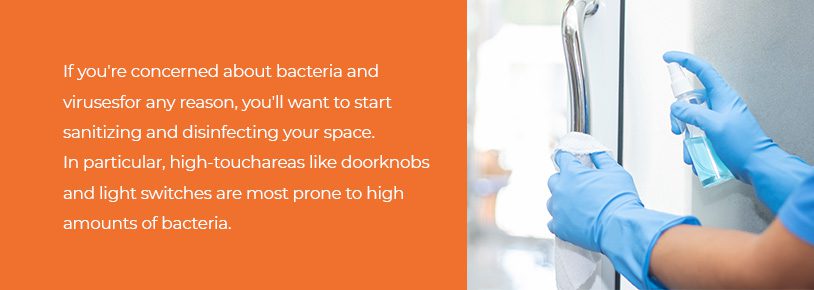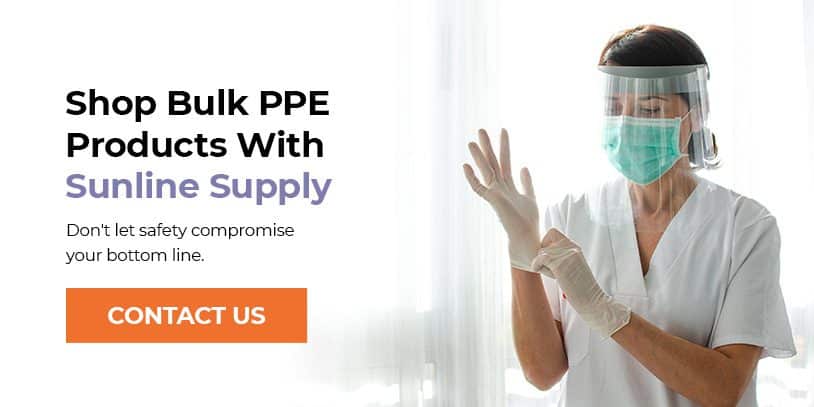
Cleaning, Sanitizing and Disinfecting: What’s the Difference?
Whether you’re nearing the summer months or preparing for the next flu season to hit your workplace, it’s important to ensure the safety of your employees and patrons. Doing so will build trust while preventing the spread of harmful diseases and illnesses. But to get started, it’s crucial to understand the difference between cleaning vs. sanitation vs. disinfection and when to do them. The experts at Sunline Supply are here to help you get started.
What Is Cleaning?
When you’re running a business, whether in a brick-and-mortar store or an office space, cleaning is the first step to protecting your workers and customers. At its core, cleaning is simply removing dirt and debris from a surface.
Often, you’ll do so with warm water and soap. Scrubbing a surface with warm water and soap can break up and remove any germs that sit on top of it. It’s important to clean up after a spill or in any other circumstance when you need to remove debris from a surface.
Keep in mind that cleaning is effective but can only do so much. That’s why you’ll want to pair your daily cleaning regimen with sanitizing and disinfecting practices.
What Is Sanitizing?
Typically, sanitizing a surface means using specific cleaning products to eliminate bacteria from a surface. This method isn’t meant for killing viruses — the main difference between sanitizing and disinfecting is only disinfecting can kill viruses. It essentially means you’re lowering the number of germs on a surface to a safer level, which is set by public health standards. When combined with consistent cleaning, sanitizing can keep your workspace safe for all employees.
Note that how much sterilization you do will depend on your business. If you’re in food service, you’ll need to constantly clean and sanitize all work areas to ensure they’re clean enough to prepare food. Consider the needs of your facility to determine whether must be a part of your daily cleaning plan.
What Is Disinfecting?
Compared to cleaning and sanitizing, disinfecting is the most effective way to kill bacteria and viruses. The Centers for Disease Control and Prevention list various ways you can disinfect types of surfaces and objects, including clothing, furniture and more. No matter what you need to disinfect, you’ll want to use the right products to do so.
It’s possible to disinfect through various methods. For instance, you can disinfect a toilet using bleach. Additionally, disinfecting wipes are available to wipe down surfaces. In general, products that kill up to 99.999% of germs can be used effectively for disinfecting a space.
Because disinfecting can be harsh, you should wear gloves and a mask when handling certain products. Be sure to open all windows and run fans to remove fumes from the area. In most cases, you’ll only have to disinfect a space frequently when an employee is ill or you’re in an industry like healthcare where employees can come into contact with bodily fluids.
Should You Clean, Sanitize or Disinfect?
The not-so-technical answer is it depends on the situation. It’s usually smart to clean your workspace at the end of each day, especially when someone in the office may be sick. If you’re in a sector like education, you’ll likely be cleaning once or twice a day because of the students. Both sanitizing and disinfecting will happen less often, as they’re more intensive.

If you’re concerned about bacteria and viruses for any reason, you’ll want to start sanitizing and disinfecting your space. In particular, high-touch areas like doorknobs and light switches are most prone to high amounts of bacteria. Taking a few moments to wipe certain areas down with disinfecting wipes during flu season will lead to a safer work environment.
Ultimately, you’ll want to evaluate the situation before cleaning or sanitizing or taking time to disinfect.
When and What to Sanitize
Consider sanitation as your intermediary between cleaning and disinfection. The idea is you want to kill germs to make your environment safer but don’t need to remove viruses from different surfaces. Often, sanitizing is enough to keep most environments operational.
No matter your industry, you want to sanitize all high-traffic areas and spaces that come into contact with food. Using certain cleaning products will kill any bacteria. However, sanitizing doesn’t always mean using cleaning products to wipe down surfaces. Technically, you sanitize cutlery and dishes when you put them in the dishwasher, as the water becomes hot enough to kill bacteria.
The bottom line is you should clean regularly and sanitize as needed. It may be beneficial to sanitize once weekly, while other businesses will need to remove bacteria more actively. Keep in mind the time of year, whether employees are sick and your facility’s use.
When and What to Disinfect
As indicated, sanitizing is often a safer, more frequent option, but disinfection is the cornerstone to preventing the spread of viruses throughout space. When disinfected properly, your workplace can be a safe environment for employees and patrons to gather.
With that in mind, it’s best to disinfect all high-traffic areas according to the situation. During flu season and the winter months in general, disinfecting will become more regular as people are more likely to become ill. If you’re in a laboratory or a healthcare facility, special disinfectant methods may be in order to frequently remove viruses from various surfaces.
For best results when disinfecting, clean, disinfect and finish with a final rise. If you’re unsure how to apply or use a product, you should consult the label beforehand. Generally, you want to disinfect when no one else will be in the building for a few hours, as doing so can be harmful.
Shop Bulk PPE Products With Sunline Supply
For a healthier and safer work environment, invest in the best personal protective equipment (PPE) for your cleaning staff. This way, they can stay protected when sanitizing and disinfecting the work area. For all of your bulk PPE product needs, Sunline Supply can get you what you need most at affordable wholesale prices. Don’t let safety compromise your bottom line.
Call us at (866) 607-0515 or contact us today to get in touch with our safety experts. Check out our blog to see what else the experts have to say.


